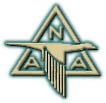 A E R O F I L E S A E R O F I L E S

North American Aviation Inc

During the prosperous, whirling 1920s, aviation was in its childhood. Companies dedicated to airplane manufacturing, engines, propellers, passenger flight and support industries sprouted across the country. On Dec 6, 1928, North American Aviation was incorporated in Delaware to become a holding company for many of these new ventures. In March 1930, it was listed on the New York Stock Exchange. North American Aviation Inc, had interests in a number of leading airlines and aircraft manufacturing companies including the General Aviation Manufacturing Corporation, located at the Curtiss-Caproni plant at Dundalk MD.

As part of the "New Deal" legislation during the Depression, the Air Mail Act of 1934 prevented an organization or its members engaged in any part of the aircraft industry from holding an airmail contract after Dec 31, 1934. Therefore, North American's airline interests were separated from its airplane-building concerns, and 39-year-old James "Dutch" Kindelberger became President and General Manager of General Aviation, leaving a career as vice president of engineering at Douglas Aircraft. When Kindelberger went east, he took with him two key aircraft designers from Douglas Aircraft, Lee Atwood and J S Smithson. In 1960, Atwood would take over from Kindelberger as head of North American Aviation.

However, in 1934 they were starting from scratch. At the time, North American had never sold a single airplane. It had done some modification work on the obsolete Berliner-Joyce P-16, and the only plane on the factory floor was an unmarketable low-wing, single-engine 10-passenger commercial transport, the GA-43 Pilgrim. The company's first government contract was not for airplanes at all -- but for 161 sets of pontoons for observation planes in service with the U S Navy. It was time for NAA designers to hit the drawing boards and come up with the company's first trainer, the NA-16, and the XO-47 three-place observation plane.

Because Southern California had excellent year-round flying weather, Kindelberger promptly moved the company, including machinery and 75 people, to a 159,000-sq ft facility on 20 acres near the edge of the Los Angeles Municipal Airport. Rent was $600 a year. Work began in temporary manufacturing quarters while the original Inglewood factory building at that location was expanded and remodeled. The new premises were occupied January 1936, with 250 people on the payroll.

Kindelberger felt that NAA would have the best chance of success if it concentrated on small, single-engined airplanes, rather than competing with manufacturers of large, multi-engined aircraft. He also knew the Army Air Corps needed a new basic trainer. However, military funding for airplanes was declining so the company also pursued overseas export contracts with other countries, including France, England, Peru, Brazil, Argentina, and Chile. As a result, the trainers would become the "bread-and-butter" product for the fledgling company.

The NA-16, a fixed-gear, two-place, low-wing monoplane, won the trainer competition in 1934 and, on Apr 1, 1935, became the first North American model-numbered airplane to be flown. It evolved into the BT-9 basic trainer, predecessor of a series of trainers that continued in uninterrupted production for 25 years. The BT-9 led to design of the Buckeye and, 50 years later, the Sabreliner, and it established NAA as a viable airplane builder. In 1936, the company was contracted to build 238 later versions of the original GA-15 observation airplane as the O-47. North American's first contract for a basic combat-type airplane came in 1937 with completion of the BC-1, a derivative of the NA-16. In February of the same year, North American built its one-and-only powerful NA-21 twin-engine "Dragon" bomber.

The experimental NA-21 Dragon, which made its first flight on New Year's Day 1937, was North American's first venture into multi-engine design. It was a high-altitude bomber, with power gun turrets and capable of carrying a large bomb load. The Air Force bought the NA-21 in 1939 and it was redesignated the XB-21.

Under the gathering impetus of impending World War II, North American forged ahead to new production records, building 41,000 airplanes during World War II. In fact, between 1935 and 1967, NAA built more military aircraft than any other airplane maker in US history.

North American Aviation continued until 1967, then merged with Rockwell-Standard as North American Rockwell. Another merger, with yet another Rockwell (Rockwell Mfg Co), in 1973 brought a new name of Rockwell International, which still continues under this name, but is largely out of the aerospace business. The Los Angeles manufacturing plant, where the Sabreliner was developed and initially produced, was sold to Northrop in 1981—commercial Sabreliners were not completed or sold at Los Angeles. Originally the "green" aircraft were handled by an independent distributor (Remmert-Werner), with most completions done in St Louis and Perryville MO. NA Rockwell bought that company in 1968 and called it the Aviation Services Division, renamed it Sabreliner Division in 1973. Sabreliner production was moved to Perryville MO in 1978, with components shipped in by truck from LA. By 1983, Rockwell Intl had lost all interest (as well as having sold the LA plant in '81) and sold the division to private investors. Sabreliner Corp is the result, and Perryville is still the core facility for Sabre support. We have a current FAA Production Certificate and all the original North American data and tools. We provide OEM support for all military and civilian Sabreliners, and also maintain/overhaul all the engines used in them (J60, JT12, CF700, TFE731). (— Alan Harris, Sabreliner Corp, 7/28/00)
|
